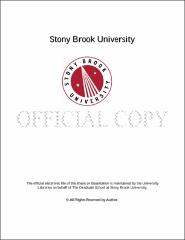| dc.identifier.uri | http://hdl.handle.net/11401/76733 | |
| dc.description.sponsorship | This work is sponsored by the Stony Brook University Graduate School in compliance with the requirements for completion of degree. | en_US |
| dc.format | Monograph | |
| dc.format.medium | Electronic Resource | en_US |
| dc.language.iso | en_US | |
| dc.publisher | The Graduate School, Stony Brook University: Stony Brook, NY. | |
| dc.type | Dissertation | |
| dcterms.abstract | The basic principle of naturalness has driven the majority of the Large Hadron Collider (LHC) program, but so far all searches for new physics beyond the Standard Model (SM) have come up empty. On the other hand, a few existing measurements of SM processes contain interesting anomalies, for instance in the measurement of the WW cross section. The deviation of WW cross section was seen both at ATLAS and CMS and both at 7 and 8 TeV. The discrepancy also became larger at 8 TeV. Combined results with LHC 7 TeV and 8 TeV implies around a three sigma deviation from the SM NLO calculation. This allows for the possibility of new physics with mass scales very close to the Electroweak Scale. We show that the addition of physics beyond the SM at electroweak scale can improve the agreement with the data. In particular supersymmetric models involving charginos, stops and sleptons all provide better fits with the data. In the case of models of sleptons that agree better with the WW data, they can also explain dark matter and the (g-2) anomaly. Furthermore, we show that there are several different classes of stop driven scenarios that not only evade all direct searches, but improve the agreement with the data in the SM measurement of the WW cross section. We also demonstrate that even if these anomalies are not due to new physics, the WW channel can also be used to derive new exclusion limits which are more powerful than existing results using the same ATLAS and CMS datasets. By examining the differential WW cross section we show that the gap between LHC and LEP exclusions can be start to be closed. In particular, we lay out a program under which the diffcult to search for regions of new physics models with large SM backgrounds can be investigated. | |
| dcterms.available | 2017-09-20T16:51:05Z | |
| dcterms.contributor | Sterman, George | en_US |
| dcterms.contributor | Meade, Patrick R | en_US |
| dcterms.contributor | Tsybychev, Dmitri | en_US |
| dcterms.contributor | Davoudiasl, Hooman. | en_US |
| dcterms.creator | TIEN, PIN-JU | |
| dcterms.dateAccepted | 2017-09-20T16:51:05Z | |
| dcterms.dateSubmitted | 2017-09-20T16:51:05Z | |
| dcterms.description | Department of Physics. | en_US |
| dcterms.extent | 107 pg. | en_US |
| dcterms.format | Application/PDF | en_US |
| dcterms.format | Monograph | |
| dcterms.identifier | http://hdl.handle.net/11401/76733 | |
| dcterms.issued | 2015-12-01 | |
| dcterms.language | en_US | |
| dcterms.provenance | Made available in DSpace on 2017-09-20T16:51:05Z (GMT). No. of bitstreams: 1
TIEN_grad.sunysb_0771E_12272.pdf: 9727054 bytes, checksum: d35c02a68a747e99ff8d73f4ca7feab3 (MD5)
Previous issue date: 1 | en |
| dcterms.publisher | The Graduate School, Stony Brook University: Stony Brook, NY. | |
| dcterms.subject | Physics | |
| dcterms.title | Investigating Electroweak Physics at the Large Hadron Collider | |
| dcterms.type | Dissertation | |

